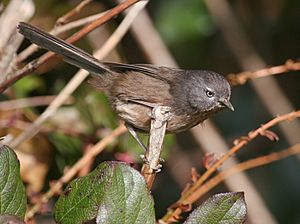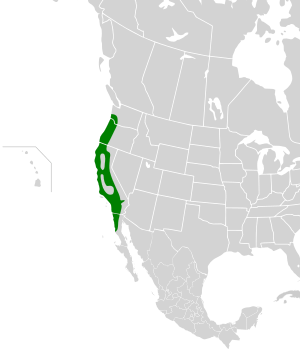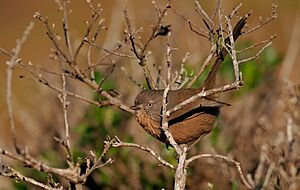Wrentit facts for kids
Quick facts for kids Wrentit |
|
|---|---|
 |
|
| Conservation status | |
| Scientific classification | |
| Genus: |
Chamaea
|
| Species: |
fasciata
|
 |
|
The wrentit (Chamaea fasciata) is a small bird that lives in chaparral, oak woodlands, and bushy areas. You can find it along the western coast of North America. It is the only species in its group, called the genus Chamaea.
For a long time, scientists have debated where the wrentit belongs in the bird family tree. Its name, "wrentit," shows this confusion. It looks a bit like both tits and wrens. However, it is not closely related to either of these birds.
Contents
What Does a Wrentit Look Like?
The wrentit is a small bird, about 15 cm (6 inches) long. It has feathers that are a plain olive, brown, or grayish color. Its wings are short, and its tail is long, often held pointing upwards. This is why some people compare it to a wren.
It has a short bill and light-colored eyes. Wrentits are shy birds, so you might not see them easily. However, you can often hear them! They make a distinct sound that is similar to a ping-pong ball bouncing on a table.
Wrentit Family Tree
Scientists have studied the wrentit for many years to figure out its true relatives. At different times, it has been placed in several different bird families. These include the long-tailed tits, true tits, and "Old World warblers."
Through DNA studies, scientists later found that the wrentit is more closely related to Sylvia warblers. It also shares links with some birds once called "babblers." This means the wrentit is the only American species of these "true" warblers.
Interestingly, birds like the Dartford warbler look very much like the wrentit. They also live in similar dry, scrubby areas around the Mediterranean Sea. However, scientists believe this is a case of convergent evolution. This means they developed similar looks because they live in similar places, not because they are super close relatives.
Where Do Wrentits Live?
The wrentit stays in one place and does not migrate. It lives in a narrow strip of coastal land in western North America. You can find it from Oregon south through California, all the way to Baja California in Mexico.
It usually lives in specific chaparral and woodland areas. Wrentits build their nests in shrubs that are about 1 meter (3 feet) tall. These shrubs can include poison oak, coyote bush, and California blackberry. Because of logging and other changes to their habitat, wrentits have recently started to spread their range, especially northward.

Wrentit Life Cycle and Habits
Wrentits choose a partner for life. They form strong pair bonds just a few months after they hatch. Both the male and female wrentit sing. You can often tell the male from the female because his song has a faster rhythm.
Both male and female wrentits also protect their territory all year long. They both help build the nest, which takes about two weeks. The female usually lays three or four eggs. Both parents take turns sitting on the eggs for about 14 days until they hatch.
The baby wrentits leave the nest after about 15 days. At this stage, they cannot fly yet. Their parents continue to feed them for another 40 days.
Wrentits find their food by moving quietly through thick bushes. They mostly eat insects they spot, like beetles, caterpillars, and ants. They also eat small berries and seeds.
See also
 In Spanish: Camea para niños
In Spanish: Camea para niños


